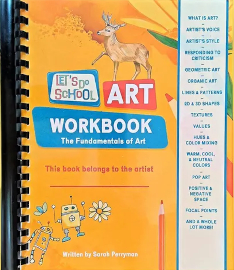Let’s Do School Art Workbook: The Fundamentals of Art by Sarah Perryman can be used for grades three through twelve, although fifth grade or higher seems best. This book is designed for students to write, draw, and color on its 325 pages, and they will need only regular pencils and colored pencils. While it can be used for teaching a group of students, it works well for parents with a single student in the lower grades and for older students working independently.
It covers fundamental art principles but is not a comprehensive drawing course. Because it is an introductory course, it should work best for students who have had little previous art instruction.
The book is illustrated in full color with some images from the public domain of older artworks, plus abstract art, Op Art, Pop Art, and many of Perryman’s own illustrations, most of which appear to have been created digitally. Along the way, Perryman introduces students to a few artists, but these are brief mentions relating to their works rather than biographical sketches.
The book is sold through Perryman’s Etsy store at a very reasonable price for such a large book printed in full color.
What It Teaches
Students learn about the use of lines to create different effects. Several lessons have students experiment with lines such as drawing a triangle with scalloped lines and drawing their own Op Art (pp. 56-75). Lessons on patterns involve shapes and colors, patterns in nature, and man-made patterns. Students learn various ways of creating textures with lines and shapes. Next, students learn to use a range of values to create 3D effects, beginning with the range from black to white, and then shifting to color to create drawings with many values of a single color. Lessons on color teach about warm, cool, and neutral colors, primary colors, and color mixing. (Perryman teaches about mixing colors using red, blue, and yellow, but she also teaches about the colors used for printing: cyan, magenta, yellow, and black. The instructional part of the book concludes with lessons on the use of positive and negative space and an understanding of focal points.
How It Works
As students learn each aspect of art, they practice applying what they learn in small assignments within the book. They begin with tracing and copying, but they also create their own drawings based on techniques used in featured artworks.
They have several assignments related to each topic and are given wide latitude as to how to complete many of them. Aside from some early lessons and pages 98 to 106 that teach the use of grid systems to copy images exactly, this is not a prescriptive course that requires students to reproduce what’s in the book.
From page 270 to the end, students work on creating their own art. They begin by making several sketches (or doodles) of three objects. From their favorite sketches, they develop an idea for a larger artwork. They create thumbnails to help them decide how to proceed and then begin their artwork. This should still be a relatively small project, probably no larger than a normal-size sheet of paper to keep it manageable. Students can work only with a pencil but can add color if they want to.
Encouragement for Students
The course includes plenty of emotional support and encouragement, including assignments to draw images that reflect their feelings and posters that are to be colored and posted. For instance, the poster on page 107 reads, “If you are being challenged you are getting better!” Then in a smaller font it says, “But Remember: Always be kind to yourself. If it’s too hard, you’re taking too big of a step. Break it down even more. Take smaller steps. Little Challenges add up to big things!” Students receive lots of this type of personal affirmation, including some questionable comments like, “All of your emotions are perfect” (p.32).
Summary
Let’s Do School Art Workbook should be easy and practical for homeschoolers. Its holistic approach, which includes encouragement along with instruction, should be especially beneficial for students who don’t consider themselves artistic or might be afraid to express themselves through art.








